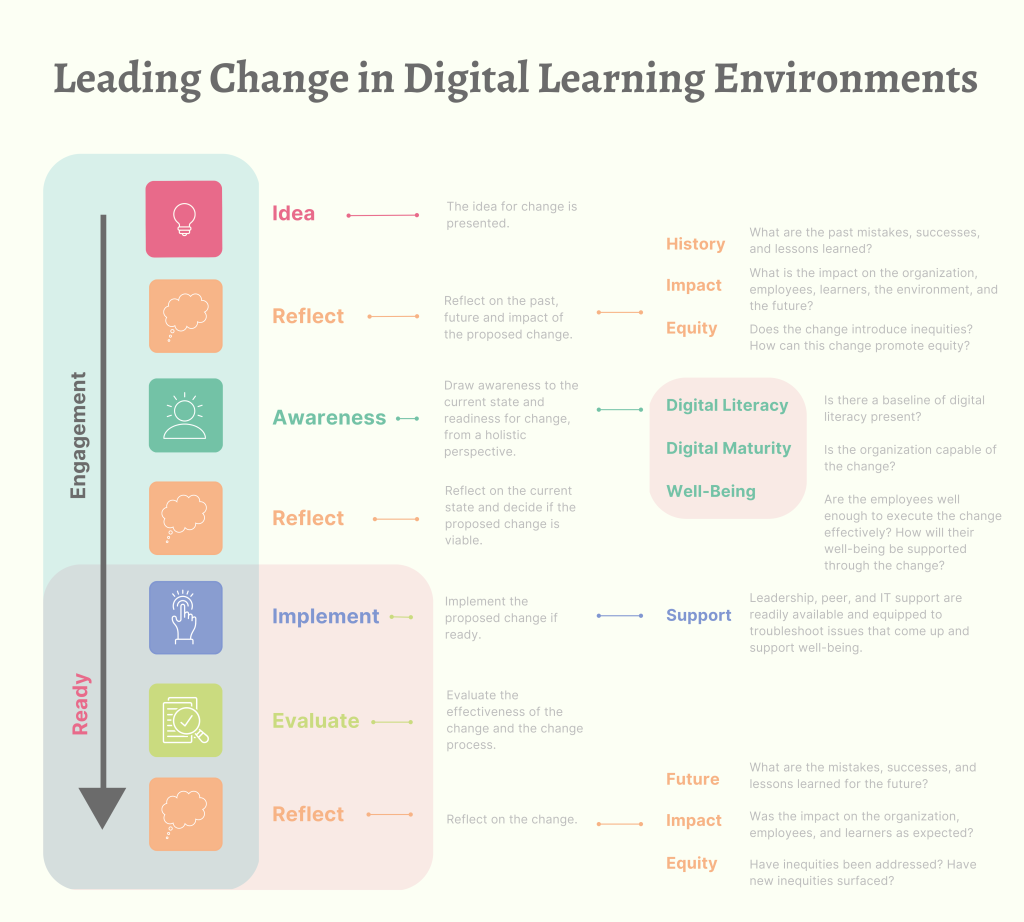Leading change in digital learning environments can be a complex process and should be considered and addressed carefully and holistically to increase the probability of success. Reflecting on the literature and the lived experiences of myself, people who lead or have led digital change, and a colleague who has experienced digital change, I have developed a model for leading change in digital learning environments, as depicted in figure 1 and described in further detail below.
Figure 1

To view figure 1 larger, click here.
Throughout the process of leading change, engagement and reflection are embedded from start to finish. These are important overarching themes reflect good leadership practice, including the ability of the leader to continuously reflect, drawing awareness to behaviours, situations, and consequences in an effort to improve organizational outcomes (Castelli, 2016). Participatory Action Research, in which the people who are involved and impacted by the change are included in the process and their perspectives and lived experiences are heard, can lead to culture change and improved success (Al-Haddad & Kotnour, 2015). Moreover, Jones (n.d.) of Race Rocks 3D suggests that the inclusion of everyone’s voice can create an atmosphere of collaboration, contributing to successful change, whereas A. Fox (personal communication, February 12, 2023) describes a sense of community and connection leading to motivation when everyone is included in the process of change. This method of change is reflected in my proposed model as ‘engagement’ and can (and should) involve employees as well as the greater community, depending on the change being implemented and who is being impacted. Furthermore, engagement throughout the process considers Indigenous perspectives on leadership that promote connecting as opposed to dividing as a central concept of leadership in a flexible, non-hierarchal structure (Julien et al., 2010). This alternative perspective on leadership is something that I wanted to consider when thinking about a model for successful change with digital learning and is also relevant during reflection, where the past and future implications are considered early in the process.
Equity is an important issue that needs to be addressed when facilitating change in digital learning environments. Introducing new technology can introduce inequities due to a lack of access, support, and digital literacy (Boyce, n.d.; Jones, n.d.; Norum, n.d.). Seeking to understand how the proposed change could contribute to inequity and developing strategies to promote equity is an important part of the reflective process and should be addressed before moving on to the implementation stage.
Awareness in my proposed model reflects mindfulness and being aware of team and individual needs (Castelli, 2016), while also drawing awareness to the current state or readiness for change. Weiner (2009) describes readiness for change as being a multi-faceted and multi-level construct. Taking this into consideration, I propose that readiness for change in digital learning environments includes digital literacy, digital maturity, and the well-being of those involved. Boyce (n.d.) of Fraser Health describes digital literacy as a significant issue when facilitating digital change and the need for supporting education pathways to establish a baseline of digital literacy to build upon. A. Fox (personal communication, February 12, 2023) also describes the need for support with digital literacy to learn new technology effectively. Digital maturity, described as an “organization’s capability to recognize and utilize the opportunities provided by the development of digital technology and the ability to carry out strategies to execute the vision” (Larjovuori et al., 2016, p. 1144), is an important precursor to implementation, signifying readiness for change. Lastly, well-being is an essential element to successful change in digital learning environments as techno-stress, which can be characterized by feelings of anxiety, fatigue, and tension, can have a negative impact on employee well-being (Larjovuori et al., 2016). Employee well-being can be enhanced through effective leadership, ongoing participatory engagement, and support through the implementation stage of change. Both Boyce (n.d.) and A. Fox (personal communication, February 12, 2023) cite psychological safety as an area of focus during change and uncertainty, which is reflected in the inclusion of well-being as a precursor to implementation.
Finally, evaluation is included in my proposed model as an important step to help understand the impact of the change. Both quantitative and qualitative feedback provide important information feeding into the final reflection, where successes, mistakes, and lessons learned are considered for adapting the current state and planning future opportunities for change. Overall, my proposed model takes a holistic and human-centred approach and an integrated method to systematically deal with change in digital learning environments (Al-Haddad & Kotnour, 2015).
References
Al-Haddad, S., & Kotnour, T. (2015). Integrating the organizational change literature: a model for successful change. Journal of Organizational Change Management, 28(2), 234-262. https://doi.org/10.1108/JOCM-11-2013-0215
Boyce, C. (n.d.). Voices of leadership [Audio recording]. Royal Roads University. https://malat-coursesite.royalroads.ca/lrnt525/schedule/voices/
Castelli, P. (2016). Reflective leadership review: a framework for improving organisational performance. Journal of Management Development, 35(2), 217-236. https://doi.org/10.1108/JMD-08-2015-0112
Jones, C. (n.d.). Voices of leadership [Audio recording]. Royal Roads University. https://malat-coursesite.royalroads.ca/lrnt525/schedule/voices/
Julien, M.H., Wright, B., & Zinni, D.M. (2010). Stories from the circle: Leadership lessons learned from aboriginal leaders. Leadership Quarterly, 21, 114-126. https://doi.org/10.1016/j.leaqua.2009.10.009
Larjovuori, R., Bordi, L., Mäkiniemi, J., Heikkilä-Tammi, K. (2016). The role of leadership and employee well-being in organizational digitalization. In T. Russo-Spena & C. Mele (Eds.), What’s Ahead in service research? New perspectives for business and society (pp. 1141-1154). European Association for Research on Services. https://www.researchgate.net/profile/Milena_Jael_Silva-Morales/publication/308033532_Changes_in_the_intellectual_structure_of_service_innovation_and_service_system_research_in_the_digital_age_a_bibliometric_analysis_from_1986_to_2015/links/5b1844000f7e9b68b4245425/Changes-in-the-intellectual-structure-of-service-innovation-and-service-system-research-in-the-digital-age-a-bibliometric-analysis-from-1986-to-2015.pdf
Norum, S. (n.d.). Voices of leadership [Audio recording]. Royal Roads University. https://malat-coursesite.royalroads.ca/lrnt525/schedule/voices/
Weiner, B. J. (2009). A theory of organizational readiness for change. Implementation Science, 4(67). https://doi.org/10.1186/1748-5908-4-67
